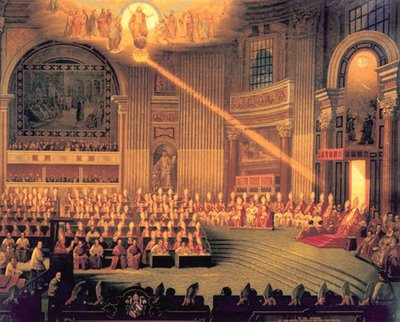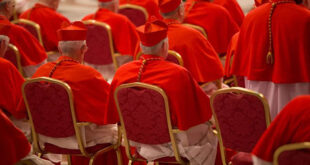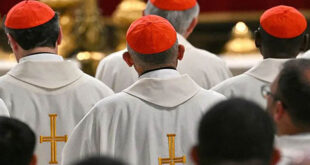Throughout history, the Catholic Church has faced both internal and external challenges that have required clarification and deepening of its doctrines. One of the most decisive moments in this process occurred during the First Vatican Council (1869-1870), when the dogma of papal infallibility was formally defined. This concept, often misunderstood, was not only crucial for the Church’s theology but remains a key point in the lives of Catholics today.
Let’s explore what papal infallibility is, why it arose in the context of Vatican I, and how this dogma continues to shape our faith and our relationship with the Pope as our spiritual leader.
Historical Context: Why the First Vatican Council?
The First Vatican Council was convened in a time of great change in Europe and the world. The Industrial Revolution was transforming social and economic structures, and the rise of nationalist movements, such as the Risorgimento in Italy, threatened the Pope’s temporal power. The Church was in a vulnerable position, both due to increasing secularization in society and the advances of rationalist thought, which questioned the truths of faith.
In this context, Pope Pius IX convened the First Vatican Council in 1869, not only to respond to external threats but also to address the internal needs of the Church. One of the main goals was to clarify the role and authority of the papacy, specifically regarding the question of papal infallibility in matters of faith and morals.
What is Papal Infallibility?
The dogma of papal infallibility was defined in Vatican I through the dogmatic constitution Pastor Aeternus. But what does it really mean that the Pope is infallible? Often, this concept has been misunderstood, as if it means the Pope can never make a mistake about anything. However, the reality is much more nuanced.
Papal infallibility means that when the Pope speaks ex cathedra (from the chair, meaning in his official capacity as the successor of Saint Peter) on matters of faith and morals, he is protected from error by the Holy Spirit. This does not refer to every statement the Pope makes, but only to those that aim to define dogmas or essential issues concerning salvation and Christian doctrine.
It’s important to highlight that infallibility is not a personal trait of the Pope as an individual, but rather a special grace granted to his office to ensure the integrity and continuity of apostolic teaching.
Why Was It Necessary to Define Papal Infallibility?
Over the centuries, the Pope’s role as the supreme leader of the Church became more consolidated. Since the first millennium, the bishops of Rome were recognized as the final authority in doctrinal disputes, but the concept of infallibility had not been formalized. Tensions between secular power and ecclesiastical authority increased over time, and by the 19th century, the situation had reached a critical point.
In the 18th and 19th centuries, Enlightenment and liberal movements increasingly challenged the Church’s authority. In Italy, the unification of the country under a secular state threatened the temporal power of the Pope, leading to the loss of the Papal States in 1870. In response to these challenges, many theologians and faithful saw the need to reaffirm the spiritual authority of the Pope at a time when his political power was crumbling.
Additionally, the growing influence of rationalism, which valued human reason over revealed faith, led to a crisis where the Church needed to clearly reaffirm its trust in the guidance of the Holy Spirit through the Pope’s magisterium. Defining the Pope’s infallibility in matters of faith and morals was a way to ensure that the Church, even in times of change and confusion, would continue to proclaim the truth without error.
The Definition of Pastor Aeternus
In Pastor Aeternus, the First Vatican Council not only defined papal infallibility but also reaffirmed the Pope’s role as the supreme pastor of the universal Church. This dogmatic constitution emphasized the primacy of the See of Saint Peter and declared that when the Pope speaks ex cathedra:
- He does so by virtue of his office as Pastor and Teacher of all Christians.
- He defines a doctrine concerning faith or morals.
- He intends that the doctrine be accepted by the entire Church.
When these conditions are met, the Pope cannot err in his teaching, as he is assisted by the Holy Spirit.
It is essential to understand that this dogma does not eliminate the role of bishops or councils. The Pope works in communion with the bishops, who also have the mission of teaching and guiding the faithful in their respective dioceses. Papal infallibility complements the infallibility of the Church as a whole, especially when the bishops and the Pope act together.
Examples of Papal Infallibility
Since the proclamation of papal infallibility, there have been few occasions when this power has been formally exercised. One of the most well-known examples is the definition of the Immaculate Conception of Mary in 1854, before Vatican I, and then the dogma of the Assumption of Mary in 1950 by Pope Pius XII. On both occasions, the Pope, after consulting the bishops worldwide, proclaimed a definitive teaching on faith that had to be believed by all Catholics.
These Marian dogmas did not emerge out of nowhere. They were based on centuries of devotion and theological reflection, and the ex cathedra proclamation simply confirmed what the Church already almost universally believed.
Infallibility in the Church Today
Some may wonder how papal infallibility remains relevant today in a pluralistic world marked by growing distrust toward authority in general. However, papal infallibility serves an essential purpose: to ensure the unity of the Church and to preserve the truth of the Gospel in an increasingly complex global context.
In a world where many voices compete to define morality and truth, papal infallibility provides a spiritual anchor. Catholics can trust that when the Pope teaches infallibly, he does so not in his own name, but as the successor of Peter, guided by the Holy Spirit.
Infallibility also has pastoral implications. It reinforces the Pope’s role as a guide in times of uncertainty. In an age where ethical and moral debates (such as those concerning life, sexuality, and social justice) are becoming more complex, the faithful need the assurance that the Church’s teachings remain firm in revealed truth, even if they challenge current cultural trends.
Conclusion: Papal Infallibility and the Challenge of Faith
The dogma of papal infallibility, far from being merely a historical declaration, continues to be a source of strength for Catholics. It reminds us that the Church is not alone in its mission to proclaim the truth, but is guided by the Holy Spirit, especially through its visible leader on earth, the Pope.
Today, more than ever, in a world of rapid changes and deep questions, papal infallibility assures that the faithful have a solid foundation in essential matters of faith and morals. It invites us to trust that, despite the turbulence and difficulties, Christ continues to guide his Church, and the Pope, as His Vicar, remains a beacon of truth amidst uncertainty.
The First Vatican Council and the proclamation of papal infallibility are a profound reminder of the Church’s eternal mission: to be a light to the world and to safeguard the faith that has been passed down by the apostles to this day.






